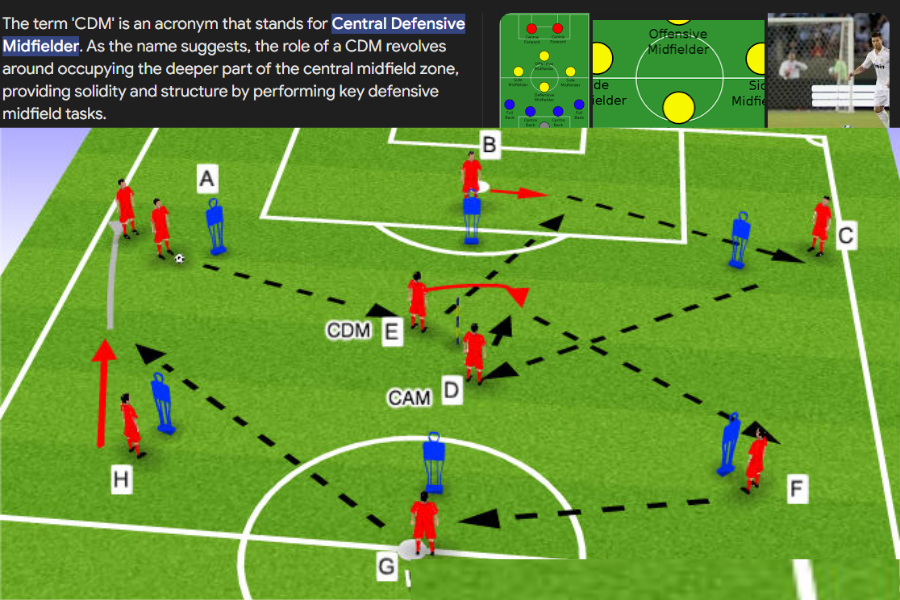CDM Soccer Position Explained: Key Responsibilities and Skills And More Exploreing Match
Soccer is one of the ultimate examples of a team sport where the performance of each player is crucial to the overall success of the team. Among the 11 players on the field, each takes on a unique position, one of which is the Central Defensive Midfielder, or CDM. This role is essential for maintaining the balance between defense and attack. Notable CDM players include N’Golo Kanté, Casemiro, and Joshua Kimmich.
What is a CDM in Soccer?
The term “CDM” in soccer refers to the Central Defensive Midfielder, a role that sits in the center of the formation, linking the midfielders and defenders. The CDM’s primary responsibility is defensive, but they also assist in transitioning play forward when the opportunity arises. If you’re aiming to refine your skills in this position, books like Soccer IQ can provide valuable insights.
This position requires a player to have a defensive mindset, often tasked with disrupting the opposition’s attacks. However, when opportunities present themselves, the CDM can also push forward to create chances, making this position one of the most important on the field.
Role of a Central Defensive Midfielder
Every player on the soccer field has a distinct role aligned with their position. Strikers focus on scoring goals, while defenders are committed to stopping the opposition from advancing. The midfielders act as the glue between defense and attack. The CDM’s role is particularly crucial because they support both the defenders and the midfielders, ensuring balance within the team.
A CDM often serves as the first line of defense in front of the backline, helping to intercept attacks and provide cover for defenders. However, when the opportunity arises, they also move up to contribute to offensive plays, making their position highly versatile.
Key Qualities of an Effective CDM
Playing as a Central Defensive Midfielder requires a unique skill set, as this position demands both defensive prowess and offensive vision. Here are some of the key qualities that define a great CDM:
1. Tackling
A good CDM must be an exceptional tackler. The ability to win the ball from the opposition, using both feet when necessary, is essential for disrupting plays and regaining possession for the team.
2. Defensive Support
Providing cover for the backline is one of the primary duties of a CDM. By positioning themselves in front of the defenders, they add an extra layer of protection, preventing opposing attackers from breaking through.
3. Communication
Communication is crucial for every soccer player, but even more so for a CDM. A CDM needs to coordinate effectively with both the defense and the attack, ensuring the team functions smoothly as a unit.
4. Stamina
CDMs need excellent stamina. They are often required to cover large areas of the field, constantly moving between the defensive and attacking halves. This role demands both physical endurance and mental resilience to stay sharp throughout the game.
5. Game Awareness
A great CDM must possess strong game-reading abilities. This means being able to anticipate the opposition’s moves, intercept passes, and make critical decisions in high-pressure moments.
Beyond these core skills, other important attributes for a CDM include:
- Strong communication skills for directing teammates and keeping the defense organized
- Exceptional ball control to maintain possession in tight situations
- Ability to execute precise long passes to initiate counter-attacks
- Physical strength and balance to win duels and hold their ground
- Agility and composure, especially when under pressure
- Speed and acceleration to cover ground quickly
All these qualities combined make a Central Defensive Midfielder an invaluable asset to any soccer team, ensuring both defensive solidity and an ability to contribute to offensive plays when needed.
Facts:
- Positioning: A Central Defensive Midfielder (CDM) plays between the defenders and central midfielders, serving as a link between the defense and attack.
- Key Role: The primary responsibility of a CDM is to protect the defense by intercepting attacks and breaking up the opponent’s play.
- Famous Players: Notable CDM players include N’Golo Kanté, Casemiro, and Joshua Kimmich, who excel in balancing defensive duties and creating offensive opportunities.
- Tackling: A CDM needs excellent tackling ability, often being the first player to disrupt the opponent’s attacks.
- Game Reading: CDMs need a high level of tactical awareness and game-reading ability to anticipate the opponent’s moves and make interceptions.
- Physical Demands: CDMs require strong stamina, as they cover large areas of the field, supporting both defense and attack.
- Communication: A key quality for a CDM is communication, both with defenders and attacking players, ensuring the team maintains its structure.
- Versatility: Though primarily defensive, a good CDM can push forward to assist in creating offensive plays when opportunities arise.
Summary:
The Central Defensive Midfielder (CDM) is one of the most crucial positions in soccer, acting as the anchor between defense and midfield. Their primary role is to protect the backline by intercepting attacks, making crucial tackles, and supporting the defenders. Additionally, CDMs help transition play from defense to offense, often contributing to attacks by pushing forward and distributing long passes. Effective CDMs must possess strong tackling skills, stamina, game awareness, and communication abilities. These skills help them disrupt opposition attacks, control the tempo of the game, and provide stability for the team. Players like N’Golo Kanté and Joshua Kimmich are prime examples of world-class CDMs who excel in balancing defensive duties with offensive contributions.
FAQs:
1. What does CDM stand for in soccer?
CDM stands for Central Defensive Midfielder, a position in soccer primarily focused on defensive tasks and supporting the midfield.
2. What is the main role of a CDM?
The main role of a CDM is to protect the defense, intercept opposition attacks, and maintain balance between defense and attack.
3. What skills are essential for a good CDM?
A good CDM needs excellent tackling, game-reading abilities, stamina, communication, and the ability to make accurate long passes.
4. How is a CDM different from other midfield positions?
While other midfield positions focus more on attacking or playmaking, the CDM’s role is predominantly defensive, offering support to defenders and stopping opposition attacks before they reach the goal area.
5. Can a CDM contribute to the attack?
Yes, although their primary role is defensive, a CDM can push forward and assist in attacks when opportunities arise, often through long passes or joining in offensive play.
6. What famous soccer players excel in the CDM role?
Players like N’Golo Kanté, Casemiro, and Joshua Kimmich are widely regarded as some of the best CDMs in modern soccer.
7. Why is stamina important for a CDM?
CDMs cover large areas of the field, moving between defense and attack, which requires high stamina to maintain their performance throughout the match.
8. How does a CDM support the defenders?
A CDM supports defenders by positioning themselves in front of the backline, intercepting attacks, and providing cover when defenders are out of position.
9. Is communication important for a CDM?
Yes, communication is crucial for a CDM to effectively coordinate with both defenders and attackers, ensuring the team maintains its shape and defensive stability.
10. What tactical qualities does a CDM need?
A CDM needs strong game awareness, tactical understanding, and the ability to read the game to anticipate and intercept the opposition’s play.
“Discover insightful tech updates and objective reviews at ObjectiveRelease.com.”






